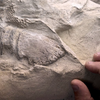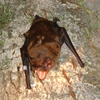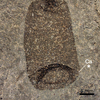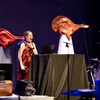A Brittlestar Specimen Fossilized During Cloning

A newly discovered brittle star, fossilized during its cloning process.
Post Author - J. Carlin Decker III
How did the complex traits and behaviors that define certain species come to be? The answers lie in hundreds of millions of years of geological time and evolutionary genealogy, but determining when exactly a trait was developed can be a significant benchmark for mapping a species’ genetic history. For a myriad of practical reasons, brittle stars have the ability to remove their legs or split themselves and grow back, and now, recent archaeological evidence shows that these stars have been behaving like this for much longer than we thought.
Brittle stars, along with their cousins sea stars, are known for their ability to asexually reproduce via the removal of limbs to grow a new organism. These stars essentially “clone” themselves by splitting off their symmetrical half to grow new arms. These fissiparous brittle stars tend to have six legs instead of the recognizable five point star. Fissiparity is a common trait observed in many species of brittle and sea stars. Scientists have been able to familiarize themselves with how these stars have been able to reproduce as they are observed today in most major marine zones, however, there have been difficulties pinpointing the exact start of this trait in the stars’ evolutionary timeline. A new discovery in southern Germany has brought forth a fossilized brittle star specimen that had recently fissioned during the late Jurassic Period.

Brittle star evolutionary chart
The fossil was found in the Nusplingen limestone deposit in 2018, and recent publications have determined that this specimen dates back to about 155 million years ago. The deposit was a lagoonal area which was home to many prehistoric marine species, and is known to contain many well-preserved fossils. The low levels of oxygen toward the bottom of the lagoon prevented decomposers from picking away at the carcasses of deceased creatures, helping create the well preserved fossils. The star appears to have three larger legs and three smaller ones. This is one of the oldest recorded specimens with evidence of star fission. As these stars tend to have a fast post-mortem decay rate, and the window of post-fission regeneration in an observable state is rather small, a specimen this old and in this shape is a very rare find.
Dr. Ben Thuy, a paleontologist at the Natural History Museum in Luxembourg, comments how the star has been kept so well intact that it looks almost as if it has been washed up and found on a beach today. This fossil has been categorized into the family of brittle stars Ophiactidae, and has been given the name Ophiactis Hex. Hex refers to the number of arms of the star, as well as a nod to the supercomputer character of the same name in Terry Prachett’s Discworld series. This specimen is one of the only known fossil records this old of a brittle star regenerating its limbs along a symmetrical plane.
Featured Product
Joe Frazier Boxing Glove
Cool Things!

Is “Paul is Dead” Dead?: Unpacking One Of Pop Culture’s Most Enduring Conspiracy Theories

Scientists Discover Hooves and Skin in Preserved Dinosaur "Mummies!"
A dinosaur discovery just in time for Halloween! In a new analysis of a group of fossils from Wyoming, Scientists have determined this group of fossils are dinosaur “mummies,” with preserved skin and even hooves.

Scientists Record a Bat Catching Birds Mid-Flight!
Bats, birds, screeches, oh my! In a reverse-Hitchcock twist, a new study reveals that a species of European bat catches and eats birds mid-flight.
Specimen Deep Dives

The House that Ruth Built: The Story of the Old Yankee Stadium

The Queen of the Skies: the Story of the Boeing 747

Old Ironsides: The USS Constitution and the Start of the U.S. Navy
Long Form Articles

The Artist Behind the Macintosh: Susan Kare and Apple Computers
While the two Steves, Jobs and Wozniak, are the most well known faces behind Apple computers, equally important to the products and culture of the company were those who crafted the experience of using their computers through design. The most notable of these visual architects was Susan Kare, a designer responsible for “humanizing” Macintosh computers.

Can I Lick It? Yes You Can!
Have you ever been unable to tell if a fossil was really a fossil, but you were too embarrassed to admit it? Have you ever wanted to lick a fossil just because, but you didn’t want to risk judgment from your peers? Well, good news! You can kill two birds with one stone! Licking a fossil can actually help you determine if it’s the real deal or just another rock.

Is It Legal To Own a Meteorite: How to Start Your Outer Space Collection!
Meteorites are some of the rarest geological specimens to be found on Earth. Of course, since these stones are not of our world, purchasing them can sometimes be a confusing process. Is it legal to own a meteorite? In short, yes! Read on for help starting your cosmic collection!



















